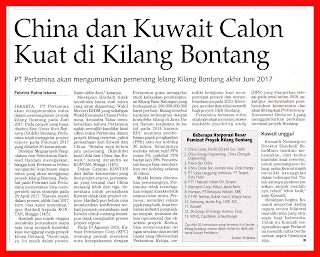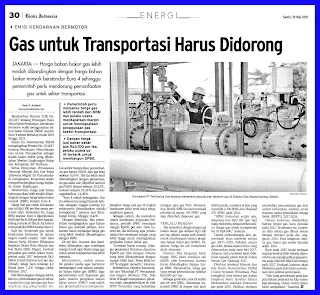Gas fuel prices are lower than the price of Euro 4-fuel oil, so the government needs to encourage the use of gas for the transportation sector.
Based on LHK Ministerial Regulation no. 20/2017 on the Implementation of the Standard of Vehicle Emission Quality, motor vehicles shall use Euro 4 standardized fuel fuel gradually from 2018 to 2021. In addition, the Ministry of ESDM issues Ministerial Regulation no. 25/2017 on the Acceleration of Gas Utilization for "Transportation as a follow-up beleid issued by the Minister of Environment and Forestry Siti Nurbaya.
Chairman of National Oil and Gas Entrepreneurs Association (Hiswana Migas) Eri Purnomohadi said consumers always consider the price rather than environmental reasons.
According to him, the selling price of gas fuel will be lower than the price of fuel oil (BBM) Euro 4 standard. Gas selling price for the vehicle is currently Rp 3. 100 per liter equivalent premium (Isp). Meanwhile, the Euro 4 standard fuel price is estimated at more than Rp 10,000 per liter when the oil refinery in the country has not produced standard Euro 4 fuel.
Currently, gas consumption for motor vehicles in the country is still low. Based on data from the Special Unit for Upstream Oil and Gas Business Unit (SKK Migas), gas sales for 2017 is 58.5 billion British thermal units per day (bbtud), but only 4.2 bbtud or 7, 2% until end of February 2017.
When compared to the sector of its speed, the utilization of gas in the transportation sector is also the lowest city gas network. For the transportation sector, gas utilization is only 0.06% and city gas is 0.04%. This is smaller than the utilization of liquefied natural gas (LNG) exports by 29.52%, industry by 23.24% and electricity by 14.08%.
"Euro 4 is already behind. The gas is actually very much even partially unabsorbed it should be used for, transportation, "he said.
Thus, if the government wants the gas fuel to be an option, consumers should get a lower gas price than the BBM. On the other hand, investors and distributors are expected to get a reasonable margin so that the gas trade business for the transportation sector can be more attractive.
According to him, to attract business actors to be interested in building gas fueling station (SPBG) units as well as the addition of gas dispenser units at public fuel stations (SPBU) that already exist. The government should consider the price of gas at the end-consumer level as well as its gas freight costs.
For example, he mentioned, to help Pertamax's sales, gas station owners get a margin of Rp 400 per liter. Therefore, he hopes that business actors can get a higher margin to increase gas fuel sales.
Previously, Director of Infrastructure and Technology of PT Perusahaan Gas Negara (Persero) Tbk. Dilo Seno Widagdo said it has identified 60 Pertamina gas stations that are facilitated by the PGN gas pipeline network. According to him, 60 gas stations will be a priority among the 150 gas stations that are ready plus gas dispenser.
TOO LOW
He mentioned, with gas fuel selling price of Rp 3,100 per lsp, business actors are hardly interested to build gas fueling stations (SPBG). Because the price did not meet the economic scale. However, if the price is higher, BBG will increasingly not in the interest by consumers because it must be compared with the price of fuel. According to him, the corresponding gas price of the economy is Rp 4,600 per lsp.
As an illustration, there are now 68 SPBG units. Meanwhile, the number of SPBG in other countries is much more, for example in Iran which has 2,350 SPBG and Thailand 470 SPBG in 2016.
"SPBG formulation already exists, now the price of Rp 3,100 [per Isp] is not economical, according to economics [gas price for transponency] it should be Rp 4,600," he said.
In another development, the government will revise the gas balance 2017-2035. In fact, the gas balance has been recorded in a book that was launched in early May 2017. Meanwhile, the book has been given to the relevant parties in the 2017 National Gas Forum.
Director General of Oil and Gas at the Ministry of Energy and Mineral Resources, I Gusti Nyoman Wiratmaja Puja, acknowledged that the gas balance data in the appendix was made based on gas consumption in 2016. In fact, there was a change in gas utilization from the electricity sector through revised electricity supply business plan (RUPTL) 2017-2026.
In his book mentioned that the import of new gas began in 2021. Meanwhile, the gas balance data attachment is made in accordance with the work plan and budget 2015. From the gas balance attachment, gas import has started since 2016.
Only in 2025 will there be a surplus even though the Masela Block is projected to start producing first gas in 2026 and East Natuna Block by 2027. Evaluation, he said, will be done on demand commitment and demand potential.
IN INDONESIAN
Gas untuk Transportasi Harus Didorong
Harga bahan bakar gas lebih rendah dibandingkan dengan harga bahan bakar minyak berstandar Euro 4 sehingga pemerintah perlu mendorong pemanfaatan gas untuk sektor transportasi.
Berdasarkan Peraturan Menteri LHK No. 20/2017 tentang Penerapan Baku Mutu Emisi Kendaraan, kendaraan bermotor wajib menggunakan bahan bakar minyak (BBM) standar Euro 4 secara bertahap mulai 2018 hingga 2021. Selain itu, Kementerian ESDM mengeluarkan Peraturan Menteri No. 25/2017 tentang Percepatan Pemanfaatan Gas untuk "Transportasi sebagai tindak lanjut beleid yang dikeluarkan Menteri Lingkungan Hidup dan Kehutanan Siti Nurbaya.
Ketua Himpunan Wiraswasta Nasional Minyak dan Gas Bumi (Hiswana Migas) Eri Purnomohadi mengatakan, konsumen selalu mempertimbangkan harga daripada alasan lingkungan.
Menurutnya, harga jual bahan bakar gas akan lebih rendah dibandingkan dengan harga bahan bakar minyak (BBM) standar Euro 4. Harga jual gas untuk kendaraan saat ini Rp 3. 100 per liter setara premium (Isp). Sementara itu, harga BBM standar Euro 4 diperkirakan lebih dari Rp 10.000 per liter saat kilang minyak di Tanah Air belum memproduksi BBM standar Euro 4.
Saat ini, konsumsi gas untuk kendaraan bermotor di dalam negeri masih rendah. Dari data Satuan Kerja Khusus Pelaksana Kegiatan Usaha Hulu Minyak dan Gas Bumi (SKK Migas), kontrak penjualan gas untuk sektor transportasi pada 2017 sebanyak 58,5 billion british thermal unit per day (bbtud), tetapi hanya terserap 4,2 bbtud atau 7,2% hingga akhir Februari 2017.
Bila dibandingkan dengan sektor lajunya, pemanfaatan gas di sektor transportasi juga jaringan gas kota tergolong yang paling rendah. Untuk sektor transportasi, pemanfaatan gas hanya 0,06% dan gas kota sebesar 0,04%. Hal itu lebih kecil dibandingkan dengan pemanfaatan gas alam cair (liquefied natural gas/LNG) ekspor sebesar 29,52%, industri sebesar 23,24% dan ketenagalistrikan 14,08%.
“Euro 4 sudah ketinggalan. Gas itu sebenarnya sangat banyak bahkan sebagian tidak terserap itu seharusnya dimanfaatkan untuk, transportasi,” katanya.
Dengan demikian, bila pemerintah menginginkan agar bahan bakar gas menjadi pilihan, konsumen harus mendapat harga gas yang lebih rendah dibandingkan dengan BBM. Di sisi lain, investor dan distributor diharapkan agar mendapat margin layak agar bisnis niaga gas untuk sektor transponasi bisa lebih menarik.
Menurutnya, untuk menarik pelaku usaha agar berminat membangun unit stasiun pengisian bahan bakar gas (SPBG) juga penambahan unit dispenser gas pada stasiun pengisian bahan bakar umum (SPBU) yang sudah ada. pemerintah harus mempertimbangkan harga jual gas di tingkat konsumen akhir serta biaya pengangkutan gasnya.
Sebagai contoh, dia menyebut, untuk membantu penjualan Pertamax, pemilik SPBU mendapat margin Rp 400 per liter. Oleh karena itu, dia berharap agar pelaku usaha bisa mendapat margin yang lebih tinggi untuk meningkatkan penjualan bahan bakar gas.
Sebelumnya, Direktur Infrastruktur dan Teknologi PT Perusahaan Gas Negara (Persero) Tbk. Dilo Seno Widagdo mengatakan, pihaknya telah mengidentifikasi 60 titik SPBU Pertamina yang terfasilitasi jaringan pipa gas PGN. Menurutnya, 60 titik SPBU itu akan menjadi prioritas di antara 150 SPBU yang siap ditambah dispenser gas.
TERLALU RENDAH
Dia menyebut, dengan harga jual bahan bakar gas sebesar Rp 3.100 per lsp, pelaku usaha sulit tertarik untuk membangun stasiun pengisian bahan bakar gas (SPBG). Pasalnya, harga itu tak memenuhi skala ekonomi. Namun, bila harganya lebih tinggi, BBG akan semakin tidak di minati oleh konsumen karena harus dibandingkan dengan harga BBM. Menurutnya, harga gas yang sesuai keekonomian sebesar Rp 4.600 per lsp.
Sebagai gambaran, saat ini sudah ada 68 unit SPBG. Sementara itu, jumlah SPBG di negara lain jauh lebih banyak, misalnya di Iran yang memiliki 2.350 SPBG dan Thailand 470 SPBG pada 2016.
“SPBG formulasi sudah ada, sekarang harganya Rp 3.100 [per Isp] tidak ekonomis, sesuai keekonomian [harga gas untuk transponasi] itu seharusnya Rp 4.600,” katanya.
Dalam perkembangan lain, pemerintah akan merevisi neraca gas 2017-2035. Padahal, neraca gas telah dicatat dalam buku yang diluncurkan pada awal Mei 2017. Adapun, buku tersebut telah diberikan kepada pihak terkait dalam Forum Gas Nasional 2017.
Direktur Jenderal Minyak dan Gas Bumi, Kementerian ESDM I Gusti Nyoman Wiratmaja Puja mengakui, data neraca gas dalam lampiran buku tersebut dibuat berdasarkan realisasi konsumsi gas pada 2016. Padahal, terdapat perubahan pemanfaatan gas dari sektor kelistrikan melalui revisi rencana usaha penyediaan tenaga listrik (RUPTL) 2017-2026.
Dalam bukunya disebutkan bahwa impor gas baru di mulai pada 2021. Sementara itu, lampiran data neraca gas dibuat sesuai dengan rencana kerja dan anggaran 2015. Dari lampiran neraca gas, impor gas sudah dimulai sejak 2016.
Baru pada 2025 mulai terdapat surplus kendati Blok Masela diproyeksi mulai menghasilkan gas pertama pada 2026 dan Blok East Natuna pada 2027. Evaluasi, katanya, akan dilakukan pada komitmen permintaan dan potensi permintaan.
Bisnis Indonesia, Page-30, Monday, May, 15, 2017









